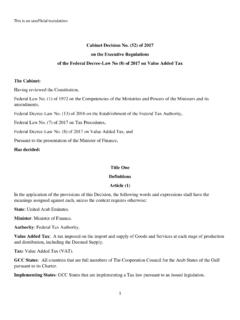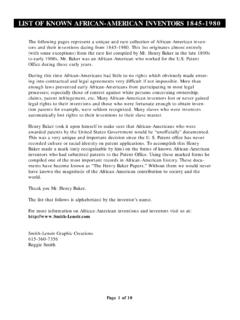Transcription of Impeachment and Removal
1 Impeachment and Removal Jared P. Cole Legislative Attorney Todd Garvey Legislative Attorney October 29, 2015. Congressional Research Service 7-5700. R44260. Impeachment and Removal Summary The Impeachment process provides a mechanism for Removal of the President, Vice President, and other civil Officers of the United States found to have engaged in treason, bribery, or other high crimes and misdemeanors. The Constitution places the responsibility and authority to determine whether to impeach an individual in the hands of the House of Representatives. Should a simple majority of the House approve articles of Impeachment specifying the grounds upon which the Impeachment is based, the matter is then presented to the Senate, to which the Constitution provides the sole power to try an Impeachment .
2 A conviction on any one of the articles of Impeachment requires the support of a two-thirds majority of the Senators present. Should a conviction occur, the Senate retains limited authority to determine the appropriate punishment. Under the Constitution, the penalty for conviction on an impeachable offense is limited to either Removal from office, or Removal and prohibition against holding any future offices of honor, Trust or Profit under the United States. Although Removal from office would appear to flow automatically from conviction on an article of Impeachment , a separate vote is necessary should the Senate deem it appropriate to disqualify the individual convicted from holding future federal offices of public trust.
3 Approval of such a measure requires only the support of a simple majority. Key Takeaways of This Report The Constitution gives Congress the authority to impeach and remove the President, Vice President, and other federal civil officers upon a determination that such officers have engaged in treason, bribery, or other high crimes and misdemeanors. A simple majority of the House is necessary to approve articles of Impeachment . If the Senate, by vote of a two-thirds majority, convicts the official on any article of Impeachment , the result is Removal from office and, at the Senate's discretion, disqualification from holding future office.
4 The Constitution does not articulate who qualifies as a civil officer. Most impeachments have applied to federal judges. With regard to the executive branch, lesser functionaries such as federal employees who belong to the civil service, do not exercise significant authority, and are not appointed by the President or an agency head do not appear to be subject to Impeachment . At the opposite end of the spectrum, it would appear that any official who qualifies as a principal officer, including a head of an agency such as a Secretary, Administrator, or Commissioner, is likely subject to Impeachment .
5 Impeachable conduct does not appear to be limited to criminal behavior. Congress has identified three general types of conduct that constitute grounds for Impeachment , although these categories should not be understood as exhaustive: (1) improperly exceeding or abusing the powers of the office; (2) behavior incompatible with the function and purpose of the office; and (3) misusing the office for an improper purpose or for personal gain. The House has impeached 19 individuals: 15 federal judges, one Senator, one Cabinet member, and two Presidents. The Senate has conducted 16 full Impeachment trials.
6 Of these, eight individuals all federal judges were convicted by the Senate. Congressional Research Service Impeachment and Removal Contents Introduction .. 1. Constitutional Provisions .. 2. Who May Be Impeached and Removed? .. 3. Impeachment Grounds .. 7. Is Impeachment Limited to Criminal Acts? .. 7. Are the Standards for Impeachable Offenses the Same for Judges and Executive Branch Officials? .. 9. Categories of Impeachment Grounds .. 11. Exceeding or Abusing the Powers of the Office .. 12. Behavior Incompatible with the Function and Purpose of the Office.
7 12. Misuse of Office for Improper Purpose or for Personal Gain .. 14. Impeachment for Behavior Prior to Assuming 15. Impeachment After an Individual Leaves Office .. 16. Overview of Impeachment 17. The House of Representatives: Sole Impeachment Power .. 17. Initiation .. 17. 18. House Action Subsequent to Receipt of Committee Report .. 19. Notification by the House and Senate Response .. 19. The Senate: Sole Power to Try 20. Trial Preparation in the Senate .. 20. Trial Procedure in the Senate .. 20. Judgment of the Senate .. 21. Judicial Review .. 21. Contacts Author Contact Information.
8 24. Congressional Research Service Impeachment and Removal Introduction The Constitution gives Congress the authority to impeach and remove the President, Vice President, and other federal civil officers 1 upon a determination that such officers have engaged in treason, bribery, or other high crimes and misdemeanors. Impeachment is one of the various checks and balances created by the Constitution, and is a crucial tool for potentially holding government officers accountable for violations of the law and abuse of power. Rooted in various constitutional provisions, Impeachment is largely immune from judicial When considering Impeachment matters, Members of Congress have historically examined the language of the Constitution; past precedents; the debates at the Constitutional Convention; the debates at the ratifying conventions; English common law and practice; state Impeachment practices.
9 Analogous case law; and historical commentaries. Although the term Impeachment is commonly used to refer to the Removal of a government official from office, the Impeachment process, as described in the Constitution, entails two distinct proceedings carried out by the separate houses of Congress. First, a simple majority of the House impeaches or formally approves allegations of wrongdoing amounting to an impeachable offense, known as articles of Impeachment . The articles of Impeachment are then forwarded to the Senate where the second proceeding takes place: an Impeachment trial.
10 If the Senate, by vote of a two-thirds majority, convicts the official of the alleged offenses, the result is Removal from office of those still in office, and, at the Senate's discretion, disqualification from holding future office. The House has impeached 19 individuals: 15 federal judges, one Senator, one Cabinet member, and two The Senate has conducted 164 full Impeachment Of these, eight individuals all federal judges were convicted by the 1. See infra Who May Be Impeached and Removed? . 2. See infra Judicial Review.. 3. See Brown, W., House Practice: A Guide to the Rules, Precedents, and Procedures of the House ch.

















